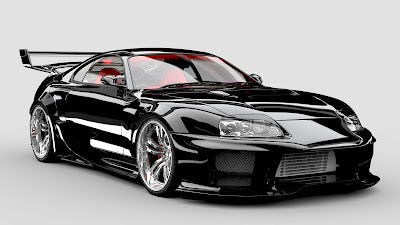Toyota Supra
Development
Motor Trend had reported a possible Supra successor could be based on the FT-HS(Future Toyota-Hybrid Sport), which debuted at the 2007 North American International Auto Show. The publication also reported that the fifth generation of the Supra could be powered by a 3.5-liter V-6 hybrid system generating over 298 kW (400 hp; 405 PS). Toyota quoted that it was not rushing for the Supra successor but instead was waiting to see how the sales and interests of the GT86/FR-S went.
In 2010, Toyota applied for a trademark for the Supra name. The trademark had to be used within three years for it to be valid. In December 2011, Autoguide reported a possible Supra replacement that would sit above the GT86.Tetsuya Tada, the chief engineer of the Toyota 86/Scion FR-S told reporters in Germany in 2012 "the president (Akio Toyoda) has asked me to make a successor to the Supra as soon as possible."
In late 2013, AutoBlog reported a Supra successor concept would be making its debut the January 2014 North American International Auto Show.On 13 January, Toyota unveiled its new FT-1 concept car. Little is known about this new concept car; other than that it has a front engine and rear wheel drive layout. Toyota also stated that their new concept car draws inspiration from Toyota's past sports cars like the 2000GT, Supra, MR-2, and 2007 FT-HS concept car. Toyota did not state whether the FT-1 would use the Supra name, or if it was even bound for production. However, Toyota did state if the FT-1 is approved from production, a price tag of around US$60,000 was to be expected for each unit.
On 10 February 2014, Toyota submitted an application to the United States Patent and Trademark Office to renew the Supra trademark.
In June 2016, a trademark application for the Supra nameplate was filed with the European Union Intellectual Property Office. According to Autocar, the new Supra was set to debut in 2018.The publication reported that the car would likely feature rear wheel drive; four-cylinder engines were expected to be available, and it had been confirmed that the car would offer a turbocharged inline-6 engine. It was believed that these engines would be supplied by BMW. Kleine Zeitung reported that the new jointly developed Supra will be produced at a Magna Steyr facility near Graz, Austria, alongside the BMW Z4 (G29). Although the sports car's name was yet to be officially confirmed, Toyota global chief engineer Tetsuya Tada said that it will likely carry the nameplate Supra, due to its name recognition and historical significance.
On 5 July 2018, Toyota Gazoo Racing announced that the Supra would return to production and compete in the US NASCAR Xfinity Series in 2019.The new Supra made its NASCAR debut in February 2019.
On 12 July 2018, a near-production model of the fifth generation of the Supra was unveiled (in camouflage) at the Goodwood Festival of Speed.
Launch
The fifth generation of the Supra made its debut at the January 2019 North American International Auto Show as a 2020 model. The car is a collaboration between Toyota and BMW and is based on the Z4. The first production model was auctioned at a price of US$2.1 million at a Barrett-Jackson auction to Craig Jackson (chairman and CEO of the Barrett-Jackson auction house) in January 2019, with 100% of the money going to the American Heart Association and the Bob Woodruff Foundation. The auction car has a one-off matte grey exterior color which is not offered on the standard Supra, as well as a red interior, metallic black 5-bolt wheels, red wing mirrors, a signature from Toyota CEO Akio Toyoda on the dashboard and VIN number 20201. Sales for the production car began in Japan on 17 May 2019. In the United States, sales began on 22 July 2019 with a starting base price tag of US$49,990.
Specifications
The Supra is powered by two BMW-sourced engine options: a turbocharged 2.0-liter inline-four or a turbocharged 3.0-litre inline-six engine. The 2.0-litre engine is currently not offered outside of Japan, leaving the 3.0-liter inline-six as the only engine option available. The 2.0-litre engine has a power output of 145–190 kW (194–255 hp; 197–258 PS) from 4,500 to 6,500 rpm or 5,000 to 6,500 rpm and 320–400 N⋅m (236–295 lbf⋅ft) of torque from 1,450 to 4,200 rpm or 1,550 to 4,400 rpm, while the 3.0-litre engine has a power output of 250 kW (335 hp; 340 PS) from 5,000 to 6,500 rpm and 500 N⋅m (369 lbf⋅ft) from 1,600 to 4,500 rpm, with power sent to the rear wheels through a ZF 8HP 8-speed automatic transmission. A manual transmission option is currently not offered. The 2.0 L model can accelerate from 0–97 km/h (0–60 mph) in 5.2 to 6.5 seconds, while the 3.0 L model can accelerate from 0–97 km/h (0–60 mph) in 4.1 seconds, 1.1 seconds quicker than the turbocharged variant of the A80 Supra and has an electronically limited top speed of 249 km/h (155 mph).
The test conducted by Car and Driver in May 2019 recorded the acceleration of the 3.0 L model from 0–97 km/h (0–60 mph) in 3.8 seconds, which is 0.3 seconds faster than the factory claimed. The 402 m (1⁄4 mile) time is also recorded in 12.3 seconds at 182 km/h (113 mph).












Comments
Post a Comment